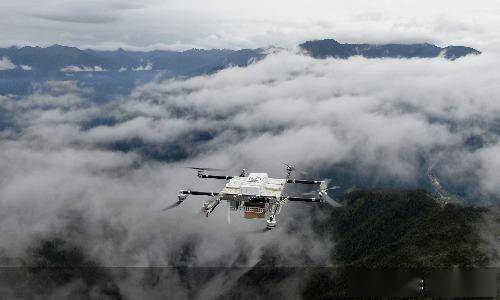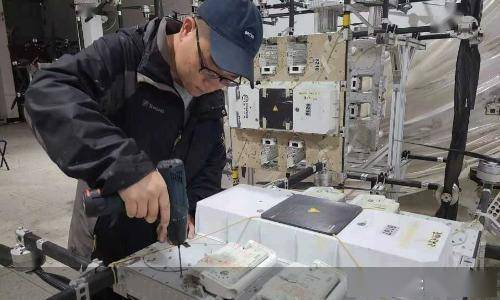Opening words: New occupations, new workers, born out of yearning, but also born out of “net”. Occupations that were originally born out of needs have become indispensable new occupations thanks to the catalysis of the Internet. Under the Internet craze, professional connotations have been reinterpreted, and professional characteristics and types are even more varied. In each era, there are always specific professional groups who are the witnesses and creators of life and business. To this end, we will use text, video and pictures to record career changes in the context of the times.
In the future, your express delivery is likely to fall from the sky, and they will ride drones over mountains and seas. In the day-to-day maintenance, overhaul and upgrade by Su Hao, a UAV assembly and repair engineer, these sophisticated and flexible aircraft are showing their amazing potential, breaking through the limitations of ground transportation, and challenging the time limit of express logistics. UAV installation and maintenance workers not only let the UAV take off, but also make it land accurately and safely. Tens of thousands of debugging times are only for express delivery to “fall from the sky” quickly and stably. With the breaking of technical cost and other bottlenecks, the era of drone delivery may be approaching.

Thousands of crazy trials to adjust and test flight at an altitude of 3,500 meters
Within 15-20 minutes, Su Hao and his team will send Matsutake mushrooms that grow on a high mountain at an altitude of 3,500 meters down the mountain. As soon as the news came out, this village in the western plateau of China exploded. After all, it has always been a tradition of villagers to climb rugged mountain roads and pick and transport matsutake by humans. It can condense hours or even a day’s work to 20 minutes, and almost no one believes that Su Hao and his team can do it.
In the eyes of people’s surprise, Su Hao is still full of confidence because he also has a group of “colleagues” named Fang Zhou. The Ark is an unmanned aerial vehicle with eight rotors that can perform flexible turns, ascent and descend, and stay in the air under the automatic control of the system. It can fly for 22 minutes with a load of 10 kg.
In fact, products like Matsutake are quite “squeaky.” You have to take it off as soon as it is fresh, otherwise once the umbrella is “opened”, the nutritional value and economic value will be quickly lost. Relying on the characteristics of drones such as flexibility, efficiency, and ability to complete instructions autonomously, Su Hao hopes to change the inefficiency of hand-carried shoulder transportation and free the villagers from time-consuming and labor-intensive transportation.
Of course, letting Matsutake “fly” down from a 3500-meter high mountain is also a scene exercise and application of SF Express in the production of fresh transportation by drone farmers. If successful, these accumulated experience will help more agricultural products go out of the mountains and increase the income of local residents.
All beginnings are hard. Compared with plains, the environment in plateau and mountainous areas is more complicated. The weather changes drastically. Rain or wind will affect the smooth operation of the machine. In addition, the steep and rugged terrain also increases the difficulty of base station construction. The drone seems to be a point-to-point flight, and behind it is a whole set of systems to support it, including weather monitoring systems, communication networking systems, etc. Su Hao and his colleagues must cooperate closely, not only to make the drone reach the destination smoothly and accurately, but also to ensure foolproof safety during the flight.
Not only must the matsutake “fly” down the mountain, but it must also land on the ground accurately and safely according to the set flight route.
For this reason, within 3 months, the team made countless adjustments and test flights, and gradually outlined the outline of the use of drones in the plateau scene, which was regarded as a whimsical concept turned into reality. This also made Su Hao deeply aware for the first time that technology can change logistics, and logistics can truly change people’s lives.
Playing with “toys”, the team of famous drones is growing
However, if you turn the time back to 2013, the drone industry will be both mysterious and unfamiliar in people’s eyes. After graduating from university, it is difficult for Su Hao to find drone-related positions in job recruitment. He was obsessed with interest during his studies and did not find the right soil for the first time. This niche field is only confined to enthusiasts. In various exchange groups.
Strictly speaking, the aerial photography of activities that people see daily, or the so-called “drone” in the fleet performance, actually tends to be more toward the concept of aviation model, and the “drone” that Su Hao specialized in at that time also belongs to In the field of model aircraft. This type of aircraft mainly relies on human control to complete performance or competitive content, and is not a drone in the strict sense.
According to the definition of the Civil Aviation Administration, a drone is an aircraft managed by a control station (including remote control or autonomous flight), also known as a remotely piloted aircraft. The ability to carry sensing, measurement and data transmission equipment and automatically perform remote tasks according to procedures has become an important feature that distinguishes UAVs from aviation models.
After graduating from university, Su Hao worked at a gas station. Although he was far from the dream of flying, after get off work, Su Hao would still spend a few hours repairing the aircraft model, and sometimes asked the “great god” in the circle about assembly problems. . “Some colleagues know that I play aeromodelling, but many people think it is a’toy’.” He said with a smile.
Unconsciously, the outside world and Su Hao’s life trajectory have quietly changed because of this “toy”.
In 2013, when Su Hao graduated, the Civil Aviation Administration successively promulgated and revised the “Regulations on the Management of Civil UAV Pilots”, “Regulations on the Operation of Light and Small UAVs (Trial)”, “Measures for the Air Traffic Management of Civil UAV Pilot Aircraft Systems”, etc. Regulations that civilian drones are more regulated at the regulatory level, which has also accelerated the use of drones in more scenarios.
By April 2014, the management of drone pilot qualification and training quality began to be taken care of by the China AOPA (Chinese Aircraft Owners and Pilots Association) under the Civil Aviation Administration, which means that drone enthusiasts will achieve “regularity”. Can pass the formal examination to become a professional drone industry practitioner.
In November 2016, Su Hao’s life trajectory ushered in a change. Based on his many years of love for drones, he almost easily obtained his own civil unmanned aircraft system pilot certificate, and finally had the opportunity to step into the industry he dreamed of. Like Su Hao, more and more job seekers are starting to flood into the drone field. In May 2017, the number of drone pilots with certification exceeded 14,000.
In February 2020, “UAV Installation, Adjustment and Maintenance Worker” officially became a new occupation and was included in the National Occupation Classification Dictionary. New occupations such as drone installation and maintenance workers and drone pilots have emerged due to the booming demand. The industry is entering a period of rapid development: According to the statistics of the Civil Aviation Administration, the number of registered drones in the industry has reached 523,600, and the annual flight volume has reached 1.594 million.
Break through spatial and geographical restrictions and build a bridge for online shopping in the mountains
After obtaining the qualification certificate, Su Hao became an unmanned aerial vehicle assembly and maintenance worker in SF Express in 2018. He summed up his career with “huge jumps”. “Before playing model airplanes was “happy flight”, but when it comes to the level of logistics operations, the requirements for the safety and stability of drones are very strict.” Daily maintenance, troubleshooting, software and hardware upgrades, Su Hao and the team There can be no mistakes. Behind every flight is a heavy responsibility.

It can be said that “black technology” such as drones really flew into people’s field of vision during the severe epidemic in 2020. In Wuhan, Shiyan, Ganzhou, Wenzhou, and Harbin, SF UAVs have built channels for transportation of materials. In the 32-day operation, drones flew more than 5,000 sorties, with a flight mileage of more than 22,000 kilometers, and more than 20 tons of materials were delivered to people.
In remote mountainous areas or scattered islands, the air superiority of drones not only eases the problem of unsalable agricultural products caused by inconvenient logistics, but also builds a bridge for residents’ online shopping. At present, Zhongtong is developing a hybrid UAV with a larger load capacity, which is expected to carry a load of 10-15 kg and a battery life of 100 minutes.
Transportation is inconvenient and labor costs are high. For these problems that plague the last mile of rural express delivery, drone delivery may become the optimal solution. In Tonglu, Zhejiang, Yunda’s 5G drone took off from an outlet in Fenshui Town, across the mountains and mountains, and delivered a Tonglu specialty Xueshuiyun green tea to customers in Zhangjiawu Village in just 16 minutes.
After several iterations, these “children” in Su Hao’s eyes have gradually grown into “reserves” of conventional capacity, expanding their potential in intra-city and inter-city high-efficiency transportation such as intra-city express delivery and inter-city express delivery. The vigorous growth of the drone industry not only enriches the competitive dimensions of enterprises in logistics and transportation such as trunk lines and branch lines, but also provides convenient and fast express services for consumers in more remote areas.
The transportation of matsutake on the plateau is just a microcosm of the drone flying in thousands of scenes, but it is deeply engraved in Su Hao’s mind. These smart and sensitive machines are breaking down barriers and filling the space-time distances between mountains and cities, inland and islands. People’s lives become different from this. More importantly, more people are understanding and approving the efforts of drone practitioners. “The hard work is worth it,” Su Hao said.
Therefore, in the field of logistics and express delivery, deep into the last kilometer or even 100 meters of the end of the consumer end, drones with wings that can fly freely set off again and again, echoing the express vehicles galloping on the ground.
Beijing Commercial Daily reporter Zhao Shu commented on He Qian



























































You must log in to post a comment.